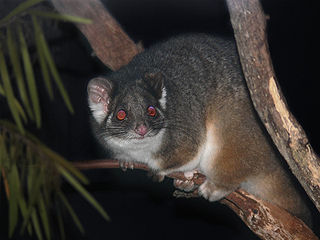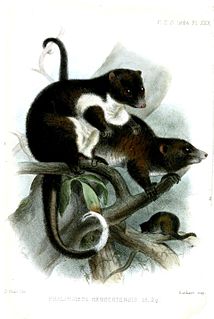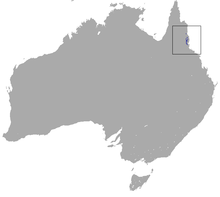
Phalangeriformes is a paraphyletic suborder of about 70 species of small to medium-sized arboreal marsupials native to Australia, New Guinea, and Sulawesi. The species are commonly known as possums, gliders, and cuscus. The common name "possum" for various Phalangeriformes species derives from the creatures' resemblance to the opossums of the Americas. However, although opossums are also marsupials, Australasian possums are more closely related to other Australasian marsupials such as kangaroos.

The Daintree rainforest is a national park in Far North Queensland, Australia, 1,757 km (1,092 mi) northwest of Brisbane and 100 km (62 mi) northwest of Cairns. It was founded in 1981 and is part of the Wet Tropics of Queensland. In 1988 it became a World Heritage Site. The park consists of two sections, with a settled agricultural area between them which includes the towns of Mossman and Daintree Village.

The Queensland tropical rain forests ecoregion covers a portion of the coast of Queensland in northeastern Australia and belonging to the Australasian realm. The forest contains the world's best living record of the major stages in the evolutionary history of the world's land plants, including most of the world's relict species of plants from the ancient supercontinent of Gondwana. The history of the evolution of marsupials and songbirds is also well represented.

The feathertail glider, also known as the pygmy gliding possum, pygmy glider, pygmy phalanger, flying phalanger and flying mouse, is a species of marsupial native to eastern Australia. It is the world's smallest gliding mammal and is named for its long feather-shaped tail.

The family Petauridae includes 11 medium-sized possum species: four striped possums, six species of wrist-winged gliders in the genus Petaurus and Leadbeater's possum, which has only vestigial gliding membranes. Most of the wrist-winged gliders are native to Australia, most of the striped possums to New Guinea, but some members of each are found on both sides of the Torres Strait.

The common ringtail possum is an Australian marsupial. It lives in a variety of habitats and eats a variety of leaves of both native and introduced plants, as well as flowers, fruits and sap. This possum also consumes a special type of faeces that is produced during the daytime when it is resting in a nest. This behaviour is called caecotrophy and is similar to that seen in rabbits.

The Daintree River is a river that rises in the Daintree Rainforest near Cape Tribulation in Far North Queensland, Australia. The river is located about 100 kilometres (62 mi) northwest of Cairns in the UNESCO World Heritage–listed Wet Tropics of Queensland. The area is now primarily a tourist attraction.

Pseudocheiridae is a family of arboreal marsupials containing 17 extant species of ringtailed possums and close relatives. They are found in forested areas and shrublands throughout Australia and New Guinea.

The greater sooty owl is a medium to large owl found in south-eastern Australia, Montane rainforests of New Guinea and have been seen on Flinders Island in the Bass Strait. They have a finely white spotted head with scattered white spots on the wings. The females are lighter colored than the males. The females' length is 37–43 cm and weighs 750-1200 g. The smaller male has a length of 37–43 cm and weighs 500-700 g. The wing length is 30–40 cm. The large dark eyes are set in a round large facial disk. The facial disk is dark gray-silver or sooty black and has a heavy black edge. The upper part of the owl is black to dark gray and the under part is lighter. The tail is short and the legs are feathered. The feet and talons are large. Their call is a piercing shriek which can last up to two seconds.

Pseudocheirus is a genus of ringtail possums. It includes a single living species, the common ringtail possum of Australia, as well as the fossil Pseudocheirus marshalli from the Pliocene of Victoria.

The striped possum or common striped possum is a member of the marsupial family Petauridae. it is found mainly in New Guinea. The species is black with three white stripes running head to tail, and its head has white stripes that form a 'Y' shape. It is closely related to the sugar glider, and is similar in appearance.

The yellow-bellied glider, also known as the fluffy glider, is an arboreal and nocturnal gliding possum that lives in native eucalypt forests in eastern Australia, from northern Queensland south to Victoria.

The greater gliders are three species of large gliding marsupials in the genus Petauroides, all of which are found in eastern Australia. Until 2020 they were considered to be one species, Petauroides volans. In 2020 morphological and genetic differences, obtained using diversity arrays technology, showed there were three species subsumed under this one name. The two new species were named Petauroides armillatus and Petauroides minor.

The Herbert River ringtail possum is a species of possum found in northeastern Queensland, Australia. It is a dark brown to black species, sometimes with a white belly. The Herbert River ringtail possum was long considered conspecific with the cinereus ringtail possum, despite the fact that they are very different in appearance. They are, however, the only members of their New Guinea-centred genus found in Australia. The Herbert River ringtail possum is restricted to tropical rainforest from Mount Lee, west of Ingham, to the Lamb Range, west of Cairns.

The cinereus ringtail possum, also known as the Daintree River ringtail possum, is a species of possum found in northeastern Queensland, Australia. It was long believed to be the same as the Herbert River ringtail possum, but has recently been separated. The two species differ considerably in appearance.
Ringtail, ring tail, or ring-tail may refer to:

The Windsor Tablelands are a series of plateaus located in Far North Queensland, Australia. The Windsor Tableland and surrounding rainforest area are contained as part of the Wet Tropics of Queensland, sitting between the Daintree Rainforest and Mount Lewis National Park. Additionally, the region is contained in the state electorate of Cook and situated in the greater Tablelands Region of North Queensland. The Tablelands hug the mountain ranges of the Great Dividing Range with the nearest town being Wujal Wujal. The Tableland area is a larger part of the Mount Windsor Forest Reserve which represents 44,000 hectares of land in the Wet Tropic region and is a conserved nature area, as proclaimed by the Government of Queensland in 2005. Predominately the majority of the Mount Windsor Tableland is closed off for any form of public use and access to the area is often only given on request. There is currently no residential population in the Mount Windsor Tableland region as a majority of the area is national park.


















